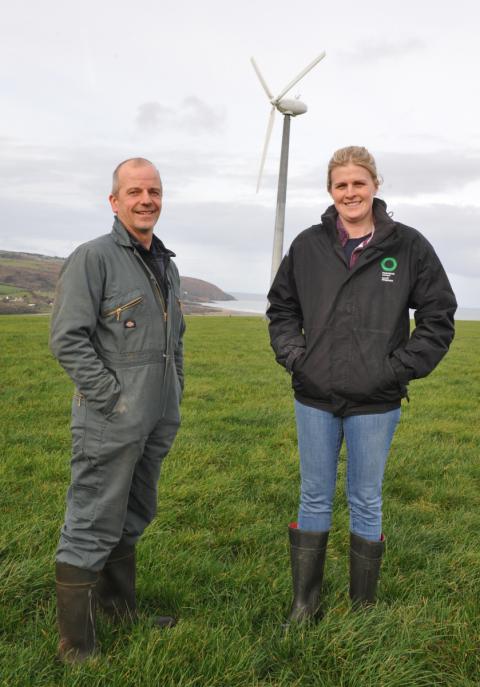26 February 2019
A Welsh dairy farm has more than halved its power costs by generating energy from solar, wind and biomass sources.
Three and a half years ago, the Phillips family were paying £14,000 a year to their electricity supplier but that bill has reduced to £7,000 since it invested in a 30kW solar system, a 20kW wind turbine and a biomass boiler.
“The cost of electricity has gone up in those three and a half years, from 12p a unit to 17p, so we are actually paying less than half the total amount we were in 2015,’’ calculates David Phillips, who farms 310-acre Trebared Farm, Cardigan, with his parents, John and Mair.
The family, who run a herd of 200 Holstein Friesians, invested around £250,000 in renewables but calculate that these will pay for themselves in less than seven years because they have a Feed-In Tariff (FIT) worth 19p/kWh.
This tariff is less than half the 40p/kWh rate paid when the FIT was introduced in 2010 and rates have since reduced further.
But, during a Farming Connect Focus Site meeting at Trebared, farmers were advised that they could still make good savings on their energy costs with on-farm renewables, even after the FIT is scrapped on March 31st 2019.
Renewable energy expert Chris Brooks said that by introducing the FIT at such a high rate in 2010, the government had triggered a ‘dash for cash’ but the emphasis had since moved away from making money to saving money since energy costs are set to continue on an upward trajectory.
In 1990, the average cost of a kWh of electricity was £0.06 and it is now £0.17. Mr Brooks predicts that by 2025 it may be £0.25, or higher.
“Energy is a significant and increasing cost to your business and you have got to look at ways of reducing this because the price you are paid for your milk, your eggs, or whatever food you produce, is unlikely to increase in line with your rising energy costs,’’ Mr Brooks advised farmers attending the Farming Connect open day.
The annual cost of electricity on an average size dairy farm is typically £55-£70/cow but for many it is much higher.
The Phillips family admit that the FIT was an incentive in their decision to invest in renewables but say they would have gone down this route even without this payment.
“If you use a lot of power and can produce it cheaper with solar, wind or biomass, it is worth doing and there is expectation from our buyers too,’’ says Mr Phillips.
“Our milk buyer has a section on the farm assurance form on renewables. Although it is not a requirement of our contract at this point in time it is a box we can tick.’’
Abigail James, Farming Connect South West Wales Dairy Technical Officer, facilitated the open day.
As energy is at the heart of farming, many farmers are taking advantage of opportunities to reduce these costs, she says.
“Self-generation of energy and energy efficiency measures not only have the potential to significantly cut a farm’s energy bills but can help protect small and large farms against future energy price increases,’’ she says.
A Farming Connect Focus Farm project at Trebared Farm has resulted in further substantial energy cost savings for the business.
When the farm’s wind turbine was installed, the business upgraded to a three-phase electricity supply, expecting the energy needs of the farm to draw equally on all three phases.
But, when a data logger was used to monitor use over an eight-day period at the end of last year, it was discovered that the system was unbalanced – two of the phases were each operating at 49% capacity but the third only at 2% because devices drawing off the system had not been equally apportioned.
This meant that the Phillips’ were buying in electricity when they didn’t need to be and at the same time had exported almost one third of their renewable generation back to the grid.
“The real answer is to change motors to three phase at the same time as installing the three phase supply,’’ Mr Brooks advises.
“The cost of unnecessarily importing electricity in the three years since the three phase was installed would have paid for that.’’
Funding for the project has been provided by the Welsh Government’s Rural Communities Rural Development Programme 2014-2020.

